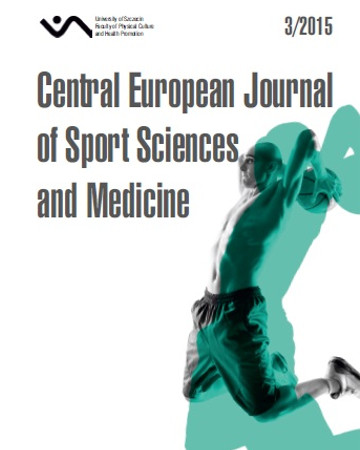
ISSN: 2300-9705
eISSN: 2353-2807
OAI
DOI: 10.18276/cej.2015.3-07




Issue archive /
Vol. 11, No. 3/2015
Biomechanical Performance Factors for Development of Minimum Disability Requirements in Para-taekwondo – Part 1
| Authors: |
Gabriel P.
Fife
Texas State University, San Marco, TX, United States of America David O’Sullivan Pusan National University, Busan, Republic of Korea |
| Keywords: | para-taekwondo classification kinematics |
| Data publikacji całości: | 2015 |
| Page range: | 7 (63-69) |
Abstract
Objective: To assess taekwondo sparring performance variables, such as joint ranges of motion, reaction times, and kicking foot speeds, to serve as a framework for developing sport-specific classification in Para-taekwondo competition. Methods: After a standard taekwondo warm up, athletes executed five popular scoring techniques, back kick, cut kick, fast kick, turning kick, and tornado kick five times each (25 total). Kinematic and kinetic variables were recorded by a motion capture system of seven infrared cameras and two force plates. Maximum joint range of motion, foot velocities, and reaction time were calculated. Results: Collapsed over kick, maximum hip abduction motion, maximum hip flexion, maximum knee flexion, peak foot velocity, reaction time for male athletes were 47.8 ±10.4°, 46.3 ±7.6°, 105.3 ±14.0°, 11.5 ±2.4 m/s, and 0.46 ±0.06 s respectively. maximum hip abduction motion, maximum hip flexion, maximum knee flexion, peak foot velocity, reaction time for female athletes were 49.1 ±6.8°, 43.9 ±11.0°, 94.2 ±13.7°, 10.9 ±2.2 m/s, and 0.48 ±0.11 s respectively. Conclusions: The results of this study provide a foundational framework for future studies designed to compare and assess Para-taekwondo athletes with various physical and neurological impairments. From this, future studies may move towards developing practical on-site sport specific testing methods which may ultimately assist in making taekwondo-specific classification for Para-taekwondo competitions.
Download file
Article file
Bibliography
| 1. | Beckman E.M., Tweedy S.M. Towards evidence based classification in Paralympic athletics: evaluating the validity and activity limitation test for use in classification of Paralympic running events. Br J Sports Med. 2009; 43 (13): 1067–1072. DOI: 10.1136/ |
| 2. | Capozzo A, Cappello A, Della Croce U, Pensalfini F. Surface-marker cluster design for 3-D bone movement reconstruction. IEE Trans Biomed Eng; 1997; 44 (12): 1165–1174. |
| 3. | Curran S.A., Frossard L. Biomechanical analyses of the performance of Parlympians: from foundation to elite level. Prosthet Orthot Int. 2012; 36 (3): 380–395. DOI: 10.1177/0309364612453257. |
| 4. | Fife G.P., O’Sullivan D.M., Pieter W., Cook D.P., Kaminski T.W. Effects of Olympic-style taekwondo kicks on an instrumented head-form and resultant injury measures. Br J Sports Med. 2012. DOI: 10.1136/bjsports-2012-090979. |
| 5. | Mori S., Ohtani Y., Imanaka K. Reaction times and anticipatory skills of karate athletes. Hum Mov Sci. 2002; (21): 213–230. |
| 6. | O’Sullivan D., Chung C.S., Lee K.K., Kim E., Kang S., Kim T., Shin I.S. Measurement and comparison of taekwondo and yongmudo turning kick impact force for two target heights. J Sp Sci Med. 2009; 8 (CSSI III): 13–16. |
| 7. | Tweedy S.M., Vanlandewijck Y.C. International Paralympic Committee position stand – background and scientific principles of classification in Paralympic sport. Br J Sports Med. 2011; 45 (4): 259–269. DOI: 10.1136/bjsm.2009.065060. Epub 2009 Oct 22. |